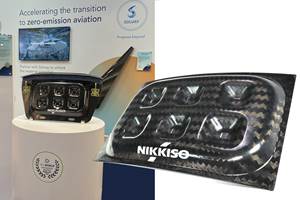Airbus CEO outlines short- and long-term goals
Guillaume Faury says recovery of commercial passenger air travel is coming, and he wants to position Airbus to be ready to serve when that day arrives.

Source | Airbus
Airbus (Toulouse, France) CEO Guillaume Faury, during an April 29 earnings call, assessed the company’s current situation and prospects for long-term growth in the wake of the nearly total global shutdown of commercial passenger air travel, caused by the coronavirus pandemic.
Faury said first that “our industry is now facing its gravest crisis in history,” and noted that the dramatic decline in commercial passenger air travel — and the reduced demand for new aircraft that followed — has compelled the company to take “prudent steps to insure the future of Airbus.” (Click here for Q1 2020 results for Airbus and Boeing.)
The company, he said, is in the midst of trying “to match production with our best understanding of this new demand, and trying to meet our customers’ expectations.” The first step in that process occurred on April 8 when Airbus announced across-the-board production rate cuts of about one-third. The company will reduce narrowbody production from 60 per month to 40 per month. It will also manufacture two A330s and six A350s per month.
Now through early June, Faury said, Airbus will continue to work with airlines and aircraft lessors to understand their aircraft needs, their financial status and how those two variables will affect Airbus’s order books. For the most part, Faury said, Airbus has managed to avoid outright order cancellations, in favor of order deferments. That said, Faury admitted that the company has “limited visibility” about how passenger air travel will return. “We are very carefully managing our ability to understand all of the implications,” he said.
Faury said he expects Airbus delivery of new aircraft, which began a downward trend in Q1 2020, will continue to be low in Q2 and Q3 2020. Following the summer, however, he expects the company will be on firmer footing and begin on a path to more a “normal” delivery pace.
However Airbus’s recovery coalesces, Faury said he expects the company’s narrowbodies — the A220, A320, A321 XLR — will lead the way as the return of domestic air travel is expected to precede international air travel. For that reason, Airbus anticipates a 3-5-year recovery window, with the A330 and A350 recovery expected closer to the 5-year end of that range. “Our product range is the right one for growing out of the crisis,” he said.
Regarding the Airbus supply chain, Faury noted that it is a complex and interdependent ecosystem vital to the company’s health and that “we need and will navigate this crisis together with them [suppliers].”
Looking ahead, Faury expects, by June, to have a clearer sense of the company’s customers’ positions and requirements; he hopes, at that time, to be able to offer more substantive guidance about how Airbus will adapt its delivery schedule. Another production rate cut is possible, he said. Other projects and efforts have also been put on hold, including expansion of the A320 final assembly line (FAL) in Toulouse and decarbonization efforts.
Ultimately, however, Faury said Airbus remains convinced that passenger air travel will return. The question, he said, is when and how. In the short term, he said, Airbus will be cautious and prudent, but long term he wants to position the company to act quickly to support the return of commercial air passenger travel. “There will be a ramp-up again,” he stated. “The question is when and at what pace. After the crisis, I am convinced people want and will still need to fly.”
Click here to download the Airbus Q1 2020 earnings report.
Related Content
JEC World 2023 highlights: Innovative prepregs, bio-resins, automation, business development
CW’s Jeff Sloan checks in with JEC innovations from Solvay, A&P, Nikkiso, Voith, Hexcel, KraussMaffei, FILL, Web Industries, Sicomin, Bakelite Synthetics, Westlake Epoxy and Reliance Industries.
Read MoreRecycling end-of-life composite parts: New methods, markets
From infrastructure solutions to consumer products, Polish recycler Anmet and Netherlands-based researchers are developing new methods for repurposing wind turbine blades and other composite parts.
Read MoreSinonus launches energy-storing carbon fiber
Swedish deep-tech startup Sinonus is launching an energy-storing composite material to produce efficient structural batteries, IoT devices, drones, computers, larger vehicles and airplanes.
Read MoreCryo-compressed hydrogen, the best solution for storage and refueling stations?
Cryomotive’s CRYOGAS solution claims the highest storage density, lowest refueling cost and widest operating range without H2 losses while using one-fifth the carbon fiber required in compressed gas tanks.
Read MoreRead Next
“Structured air” TPS safeguards composite structures
Powered by an 85% air/15% pure polyimide aerogel, Blueshift’s novel material system protects structures during transient thermal events from -200°C to beyond 2400°C for rockets, battery boxes and more.
Read MoreDeveloping bonded composite repair for ships, offshore units
Bureau Veritas and industry partners issue guidelines and pave the way for certification via StrengthBond Offshore project.
Read MorePlant tour: Daher Shap’in TechCenter and composites production plant, Saint-Aignan-de-Grandlieu, France
Co-located R&D and production advance OOA thermosets, thermoplastics, welding, recycling and digital technologies for faster processing and certification of lighter, more sustainable composites.
Read More


























